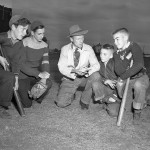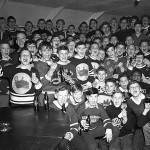To call Edmonton a hockey city is obvious. Many little ones learn to skate before preschool, and an enthusiasm for the sport is felt with equal measure in the minor and major leagues. Those raised in Edmonton can most likely recall at least one, if not hundreds, of early morning treks to city rinks to either play or watch a brother, sister, parent, cousin, friend play hockey. Was it cold? Yes. Dark? Most likely. But it is a rite of passage for Edmontonians, and cause for many a hot beverage run.
For the little learn-to-skate tykes who go on to play bantam and midget, one of Edmonton’s competitive hockey clubs often becomes part of their personal histories. Hockey clubs are where boys and girls get loyal and serious. They keep their equipment in club hockey bags. Press club stickers on their helmets. Don wool coats with embroidered club logos over their suit and tie before games. And when their minor hockey days are over, they often participate in club life as volunteer alumni.
The Maple Leaf Athletic Club is one such organization, and it’s been organizing minor hockey teams in Edmonton’s North East Zone since Henry White founded it in 1931. Why the Maple Leafs moniker? At the start of the 1930s the City of Edmonton set up a temporary rink on 118th Avenue, between 96th and 97th Street, and called it the Maple Leaf Gardens after the historic rink that was home to the Toronto Maple Leafs. Edmonton’s version only lasted one winter, but that was enough time for White to name the new club[1].
White was the son of a minister, involved with cubs and scouts, and he worked with underprivileged children[2]. His goal was to create a positive community around sport for the area’s young men (girls didn’t participate in the club’s early days like they do today), and under the Maple Leaf Athletic club, he started organizing hockey teams, along with soccer, football, track and field, lacrosse and baseball teams to keep the boys busy in the off-season[3]. The first hockey team was made up of boys of bantam age (14 and under) playing in the midget league (17 and under). Not surprisingly, they didn’t do too well that season. But the next year their experience paid off, with the team winning the league, then the city, then defeating a team from Calgary for the provincial title[4]. A peewee program started soon after,[5] with the club transitioning back out of peewee in the late 1950s, early 1960s to focus on its bantam and midget programs[6]. Over the years, the club decided to focus solely on hockey, slowly phasing out the other sports. In the early 1950s the Edmonton Football Association was formed and sponsored the Edmonton Maple Leafs football team, which, once separated from the Maple Leaf Athletic Club, changed its name to the Edmonton Wildcats and they are part of the Canadian Junior Football League to this day[7].
In the early days of minor hockey in Edmonton, athletes weren’t suited up in an armour of padding like they are today. Innovation in hockey equipment aside, the financial depression of the ‘Dirty Thirties’ meant that skates might be hand-me-downs and store catalogues did double duty as shin pads, secured on legs with a few wraps of tape[8]. The club provided sticks and other equipment was shared between teams, with the Maple Leaf teams facing off against Edmonton’s other clubs and community league teams once or twice a week.
Athletes registered to play through Edmonton’s minor hockey association, and those that couldn’t afford to play would have their fees covered by the club, with the dedicated alumni eventually stepping in to raise funds for this purpose[9]. It truly was a team sport running a hockey club in the mid-1900s. Volunteers organized the club and coached the teams, alumni volunteers raised funds, the Ladies Auxiliary ran fundraising initiatives and recognition programs, such as player of the month, and sponsors such as United Cycle provided equipment and funds for teams—and this spirit of volunteerism and community contribution is just as strong today.
In the early years, there is record of United Cycle providing the Maple Leaf Athletic Club with equipment and forgiving payments when times got tough for the club[10]. Throughout the club’s history, hard times were typically of a financial nature, but the club always managed to stay afloat[11]. The Maple Leaf Athletic Club never missed a year of hockey programming since its founding in 1931, with teams forming and playing even through the tumultuous years of World War II[12]. This is in large part thanks again to the club’s strong volunteer base. Throughout the years the executive board held casinos, bingos and raffles, with the alumni group doing the same[13]. As much as the club fostered excellence in sport for its young athletes, it also touched older generations—parents, past players, hockey lovers—who found community through the club.
And what’s a club without a clubhouse? Throughout the years, the Maple Leaf Athletic Club has found a home in building basements, above ground in spaces secured through club member contacts, and today it occupies a converted warehouse[14]. The club moved into the space in the mid-1970s, gutting it and extending the top floor to the back of the building, installing a kitchen and boardroom, and creating a hall with a photo archive. The photo archive, dreamed up by the club’s former president and historian, Allen Osmak, whose sons played for the Maple Leaf Athletic Club, was a passion project of a group of alumni in the mid-nineties. The group met every Wednesday morning over a few years, building out the displays and ending each of their shifts with lunch at a nearby Tim Horton’s.
A club that started in Edmonton’s temporary outdoor rinks is now a well-oiled 85-year-old machine that continues to inspire athletes, coaches, parents, volunteers and alumni alike to move hockey in Edmonton forward. A story of community building and a spirit of volunteerism emerges, connecting Henry White’s idea to start a hockey club for youth in 1931 to the present. Today, heated indoor rinks make the game-watching experience more enjoyable for players and spectators alike, but Edmonton’s crowded outdoor rinks tell their own story: there’s nothing quite like coming together with those in your community for a good old outdoor hockey game—something Henry White knew very well.
Sources:
[1] http://avenuehistory.org/2013/01/edmontons-maple-leaf-gardens/
[2] Bob Krewenchuk, current MLAC president and historian
[3] http://mapleleafmha3.ramp190.com/default.aspx?p=clubhistory
[4] http://mapleleafmha3.ramp190.com/default.aspx?p=clubhistory
[5] http://mapleleafmha3.ramp190.com/default.aspx?p=clubhistory
[6]Allen Osmak, former MLAC president and historian
[7] http://www.edmontonwildcats.com/team-history/
[8]Allen Osmak
[9]Allen Osmak
[10] Bob Krewenchuk
[11]Allen Osmak
[12] Bob Krewenchuk
[13]Allen Osmak
[14]Allen Osmak
© 2016 Moly Milosovic



